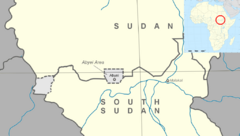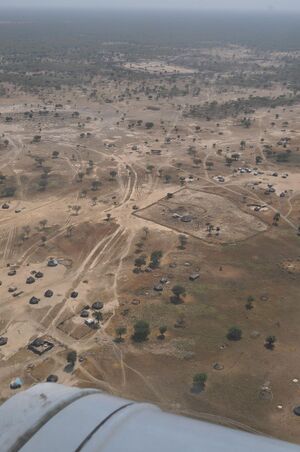Abyei Republic
United Abyei Republic جمهورية أبيي | |
|---|---|
| Motto: "For the Freedom of All" | |
| Anthem: "Our Flag Flies High" | |
 Location of Abyei Republic | |
| Capital | Stolica |
| Government | Federal provisional unity government |
• Chief Corpral | Allen Hanna |
| Establishment | |
• Abyei Independence Treaty | 26 October 2022 |
| Area | |
• Total | 10,546 km2 (4,072 sq mi) |
| Population | |
• 2022 estimate | 25,675,100 |
| Time zone | UTC+2 (Central Africa Time) |
The United Abyei Republic, formerly known as the Abyei Republic or UAR, is a micronation in Northern Africa. Abyei is landlocked between the Republic of Sudan and the Republic of South Sudan. Abyei was established on October 26th, 2022 by Allen Hanna. It has a population of 124,391 and a size of 10,546 km2 (4,072 sq mi).
History
The Sudan Tribune claims that the Dajo people were located in the region of Abyei before the seventeenth century, before being displaced by new migrants. From at least the eighteenth century Abyei was inhabited by the agro-pastoralist Ngok Dinka, a sub-group of the Dinka of Southern Sudan. The Messiria, a nomadic Arab people, who spend most of the year around their base at Muglad in northern South Kurdufan, would graze their cattle south to the Bahr river basin in Abyei during the dry season. Abyei's permanent residents were thus the southern Dinka, but half the year the Dinka were outnumbered by the Muslim, northern Misseriya. At the establishment of the Anglo-Egyptian Condominium, the Messiria were predominantly located in the province of Kordofan (considered "northern"), while the Ngok Dinka were located in Bahr el Ghazal (considered "southern"). In 1905, after continued raids by the Messiria into Ngok Dinka territory, the British redistricted the nine Ngok Dinka chiefdoms into Kordofan. The reason was threefold: to protect the Ngok Dinka from raids by the Messiria and thus pacify the area; to demonstrate that a new sovereign power was in control, and to bring the two feuding tribes under common administration. When the British left in 1956, they left the status of Abyei unclear. The two peoples began to take separate paths with the onset of the First Sudanese Civil War (1956–1972), in particular the 1965 massacre of 72 Ngok Dinka in the Misseriya town of Babanusa. The Ngok Dinka were thus drawn to the Anyanya, while the Messiria were favored by the Khartoum-based government and became firmly associated with the north. The 1972 Addis Ababa Agreement that ended the war included a clause that provided for a referendum allowing Abyei to choose to remain in the north or join the autonomous South. This referendum was never held and continued attacks against Ngok Dinka led to the creation of the Ngok Dinka unit in the small Anyanya II rebellion, which began in Upper Nile in 1975. The discovery of oil in the area, among other north-south border regions, led President Gaafar Nimeiry to try the first of many initiatives to redistrict oil-rich areas into the northern administration.
The Ngok Dinka unit of Anyanya II formed one of the foundations of the rebel movement at the beginning of the Second Civil War in 1983. Many Ngok Dinka joined the rebels upon the outbreak of hostilities. Partially as a result of their early entry into the war, many Ngok Dinka rose to leadership positions in the Sudan People’s Liberation Army (SPLA), becoming closely associated with John Garang. In contrast, the Messiria joined the hostilities on the side of the government in the mid-1980s. They formed frontline units as well as Murahleen, mounted raiders that attacked southern villages to loot valuables and slaves. By the end of the war, the intense fighting had displaced most Ngok Dinka out of Abyei, which the Misseriya state as justification for ownership of the area.
In 2022, the Abyei Area was claimed by a man named Allen Hanna who went on to establish the United Abyei Republic. The UAR, or Abyei Republic, was a micronation, a small area or political entity that claims national sovereignty but is not recognized by other sovereign states. The nation is mainly influenced by the United Nations as the Abyei area was originally administered by the UN. Allen Hanna soon started annexing other territories that would become future zones for the nation.
Government
Towns and Villiages

A list of the many towns and villages in the Abyei Republic.
- Abyei City
- Agok
- Al Malamm
- Awolnhom
- Bargnop
- Dokura
- Fyok
- Lukji
- Mokwei
- Umm Geren
- Makhir Abior
- Amiet
- Lou
- Kolom
Oil Reserves
Abyei is situated within the Muglad Basin, a large rift basin that contains several hydrocarbon accumulations. Oil exploration was undertaken in Sudan in the 1970s and 1980s. A period of significant investment in Sudan’s oil industry occurred in the 1990s and Abyei became a target for this investment. By 2003 Abyei contributed more than one-quarter of Sudan’s total crude oil output. Production volumes have since declined and reports suggest that Abyei’s reserves are nearing depletion. An important oil pipeline, the Greater Nile Oil Pipeline, travels through the Abyei area from the Heglig and Unity oil fields to Port Sudan on the Red Sea via Khartoum. The pipeline is vital to Sudan’s oil exports which have boomed since the pipeline commenced operation in 1999.
Military

The Abyei Republics' main defense force is the Abyei Ground Forces (AGF) along with the Abyei Air Corps (AAC). The AGF manages in ground operations and attacks while the AAC manages in air defense. Sometimes both the AGF and the AAC will participate in the same operations.
Foreign Relations
 Imperial Republic of Usona
Imperial Republic of Usona Kingdom of Obelska
Kingdom of Obelska Republic of Martiaterra
Republic of Martiaterra Socialist Republic of Kanazia
Socialist Republic of Kanazia Republic of Marla
Republic of Marla Empire of Artemiso
Empire of Artemiso
Culture
Religion
Much of the population of the UAR is Christian but some tribes in the UAR have their own beliefs and religions as well.

